Effects of Methylenediphenyl 4,4’-Diisocyanate and Maleic Anhydride as Coupling Agents on the Properties of Polylactic Acid/Polybutylene Succinate/Wood Flour Biocomposites by Reactive Extrusion
Abstract
1. Introduction
2. Materials and Methods
2.1. Materials
2.2. Methods
2.2.1. Melt Compounding and Specimen Preparation
2.2.2. Characterization of Composites
2.2.3. Mechanical Properties
2.2.4. Thermal Properties
2.2.5. Viscoelastic Properties
3. Results and Discussion
3.1. Characterization of Composites
3.2. Mechanical Properties
3.3. Thermal Properties
3.4. Viscoelastic Properties
4. Conclusions
Author Contributions
Funding
Acknowledgments
Conflicts of Interest
References
- Spierling, S.; Knupffer, E.; Behnsen, H.; Mudersbach, M.; Krieg, H.; Springer, S.; Albrecht, S.; Herrmann, C.; Endres, H.J. Bio-based plastics—A review of environmental, social and economic impact assessments. J. Clean. Prod. 2018, 185, 476–491. [Google Scholar] [CrossRef]
- Gironi, F.; Piemonte, V. Bioplastics and Petroleum-based Plastics: Strengths and Weaknesses. Energy Source Part A 2011, 33, 1949–1959. [Google Scholar] [CrossRef]
- Chan, C.M.; Vandi, L.J.; Pratt, S.; Halley, P.; Richardson, D.; Werker, A.; Laycock, B. Composites of Wood and Biodegradable Thermoplastics: A Review. Polym. Rev. 2018, 58, 444–494. [Google Scholar] [CrossRef]
- Jamshidian, M.; Tehrany, E.A.; Imran, M.; Jacquot, M.; Desobry, S. Poly-Lactic Acid: Production, Applications, Nanocomposites, and Release Studies. Compr. Rev. Food Sci. Food 2010, 9, 552–571. [Google Scholar] [CrossRef]
- Liu, H.Z.; Zhang, J.W. Research Progress in Toughening Modification of Poly (lactic acid). J. Polym. Sci. Polym. Phys. 2011, 49, 1051–1083. [Google Scholar] [CrossRef]
- Nagarajan, V.; Mohanty, A.K.; Misra, M. Perspective on Polylactic Acid (PLA) based Sustainable Materials for Durable Applications: Focus on Toughness and Heat Resistance. ACS Sustain. Chem. Eng. 2016, 4, 2899–2916. [Google Scholar] [CrossRef]
- Hamad, K.; Kaseem, M.; Ayyoob, M.; Joo, J.; Deri, F. Polylactic acid blends: The future of green, light and tough. Prog. Polym. Sci. 2018, 85, 83–127. [Google Scholar] [CrossRef]
- Su, S.; Kopitzky, R.; Tolga, S.; Kabasci, S. Polylactide (PLA) and Its Blends with Poly (butylene succinate) (PBS): A Brief Review. Polym. Basel 2019, 11, 1193. [Google Scholar] [CrossRef]
- Liu, R.; Luo, S.P.; Cao, J.Z.; Peng, Y. Characterization of organo-montmorillonite (OMMT) modified wood flour and properties of its composites with poly (lactic acid). Compos. Part A Appl. Sci. 2013, 51, 33–42. [Google Scholar] [CrossRef]
- George, J.; Sreekala, M.S.; Thomas, S. A review on interface modification and characterization of natural fiber reinforced plastic composites. Polym. Eng. Sci. 2001, 41, 1471–1485. [Google Scholar] [CrossRef]
- Yu, T.; Hu, C.Q.; Chen, X.J.; Li, Y. Effect of diisocyanates as compatibilizer on the properties of ramie/poly (lactic acid) (PLA) composites. Compos. Part A Appl. Sci. 2015, 76, 20–27. [Google Scholar] [CrossRef]
- Zeng, J.B.; Li, K.A.; Du, A.K. Compatibilization strategies in poly (lactic acid)-based blends. RSC Adv. 2015, 5, 32546–32565. [Google Scholar] [CrossRef]
- Darie, R.N.; Bodirlau, R.; Teaca, C.A.; Macyszyn, J.; Kozlowski, M.; Spiridon, I. Influence of Accelerated Weathering on the Properties of Polypropylene/Polylactic Acid/Eucalyptus Wood Composites. Int. J. Polym. Anal. Charact. 2013, 18, 315–327. [Google Scholar] [CrossRef]
- Li, L.Z.; Song, G.L.; Tang, G.Y. Novel Biodegradable Polylactide/Poly (butylene succinate) Composites via Cross-Linking with Methylene Diphenyl Diisocyanate. Polym. Plast. Technol. 2013, 52, 1183–1187. [Google Scholar] [CrossRef]
- Pan, H.W.; Li, Z.L.; Yang, J.; Li, X.; Ai, X.; Hao, Y.P.; Zhang, H.L.; Dong, L.S. The effect of MDI on the structure and mechanical properties of poly (lactic acid) and poly(butylene adipate-co-butylene terephthalate) blends. RSC Adv. 2018, 8, 4610–4623. [Google Scholar] [CrossRef]
- Raquez, J.M.; Narayan, R.; Dubois, P. Recent advances in reactive extrusion processing of biodegradable polymer-based compositions. Macromol. Mater. Eng. 2008, 293, 447–470. [Google Scholar] [CrossRef]
- Feldman, D. Polyolefin, olefin copolymers and polyolefin polyblend nanocomposites. J. Macromol. Sci. Part A 2016, 53, 651–658. [Google Scholar] [CrossRef]
- Lv, S.S.; Gu, J.Y.; Tan, H.Y.; Zhang, Y.H. Modification of wood flour/PLA composites by reactive extrusion with maleic anhydride. J. Appl. Polym. Sci. 2016, 133, 43295. [Google Scholar] [CrossRef]
- Liminana, P.; Garcia-Sanoguera, D.; Quiles-Carrillo, L.; Balart, R.; Montanes, N. Development and characterization of environmentally friendly composites from poly(butylene succinate) (PBS) and almond shell flour with different compatibilizers. Compos. Part B Eng. 2018, 144, 153–162. [Google Scholar] [CrossRef]
- Saeed, U.; Nawaz, M.A.; Al-Turaif, H.A. Wood flour reinforced biodegradable PBS/PLA composites. J. Compos. Mater. 2018, 52, 2641–2650. [Google Scholar] [CrossRef]
- Nam, G.Y.; Oh, J.S.; Park, I.K.; Luong, N.D.; Yoon, H.K.; Lee, S.H.; Lee, Y.; Yun, J.H.; Lee, C.G.; Hwang, S.H. High molecular-weight thermoplastic polymerization of kraft lignin macromers with diisocyanate. BioResources 2014, 9, 2359–2371. [Google Scholar] [CrossRef]
- Zhang, Y.; Jiang, Y.; Liu, X.; Lv, S.; Cao, J.; Tan, H.; Gu, J. Properties of grafted wood flour filled poly(lactic acid) composites by reactive extrusion. J. Adhes. Sci. Technol. 2018, 32, 429–443. [Google Scholar] [CrossRef]
- Baek, B.S.; Park, J.W.; Lee, B.H.; Kim, H.J. Development and Application of Green Composites: Using Coffee Ground and Bamboo Flour. J. Polym. Environ. 2013, 21, 702–709. [Google Scholar] [CrossRef]
- Lee, S.H.; Wang, S.Q. Biodegradable polymers/bamboo fiber biocomposite with bio-based coupling agent. Compos. Part A Appl. Sci. 2006, 37, 80–91. [Google Scholar] [CrossRef]
- Ohkita, T.; Lee, S.H. Effect of aliphatic isocyanates (HDI and LDI) as coupling agents on the properties of eco-composites from biodegradable polymers and corn starch. J. Adhes. Sci. Technol. 2004, 18, 905–924. [Google Scholar] [CrossRef]
- Gunning, M.A.; Geever, L.M.; Killion, J.A.; Lyons, J.G.; Higginbotham, C.L. Improvement in Mechanical Properties of Grafted Polylactic Acid Composite Fibers via Hot Melt Extrusion. Polym. Compos. 2014, 35, 1792–1797. [Google Scholar] [CrossRef]
- Pilla, S.; Gong, S.; O’Neill, E.; Rowell, R.M.; Krzysik, A.M. Polylactide-pine wood flour composites. Polym. Eng. Sci. 2008, 48, 578–587. [Google Scholar] [CrossRef]
- Hassan, E.; Wei, Y.; Jiao, H.; Muhuo, Y. Dynamic mechanical properties and thermal stability of poly (lactic acid) and poly (butylene succinate) blends composites. J. Fiber Bioeng. Inform. 2013, 6, 85–94. [Google Scholar]
- Lee, S.Y.; Kang, I.A.; Doh, G.H.; Yoon, H.G.; Park, B.D.; Wu, Q.L. Thermal and mechanical properties of wood flour/talc-filled polylactic acid composites: Effect of filler content and coupling treatment. J. Thermoplast. Compos. 2008, 21, 209–223. [Google Scholar] [CrossRef]
- Seo, Y.-R.; Kim, B.-J.; Lee, S.-Y. Effects of Nanoclay and Glass Fiber on the Microstructural, Mechanical, Thermal, and Water Absorption Properties of Recycled WPCs. J. Korean Wood Sci. Technol. 2019, 47, 472–485. [Google Scholar]
- Carmona, V.B.; Correa, A.C.; Marconcini, J.M.; Mattoso, L.H.C. Properties of a Biodegradable Ternary Blend of Thermoplastic Starch (TPS), Poly (epsilon-Caprolactone) (PCL) and Poly (Lactic Acid) (PLA). J. Polym. Environ. 2015, 23, 83–89. [Google Scholar] [CrossRef]
- Mani, R.; Bhattacharya, M.; Tang, J. Functionalization of polyesters with maleic anhydride by reactive extrusion. J. Polym. Sci. Part A Polym. Chem. 1999, 37, 1693–1702. [Google Scholar] [CrossRef]
- Leu, Y.Y.; Ishak, Z.A.M.; Chow, W.S. Mechanical, thermal, and morphological properties of injection molded poly (lactic acid)/SEBS-g-MAH/organo-montmorillonite nanocomposites. J. Appl. Polym. Sci. 2012, 124, 1200–1207. [Google Scholar] [CrossRef]
- Li, B.H.; Yang, M.C. Improvement of thermal and mechanical properties of poly (L-lactic acid) with 4, 4-methylene diphenyl diisocyanate. Polym. Adv. Technol. 2006, 17, 439–443. [Google Scholar] [CrossRef]
- Yu, T.; Jiang, N.; Li, Y. Study on short ramie fiber/poly (lactic acid) composites compatibilized by maleic anhydride. Compos. Part A Appl. Sci. 2014, 64, 139–146. [Google Scholar] [CrossRef]
- Phua, Y.J.; Chow, W.S.; Ishak, Z.A.M. Reactive processing of maleic anhydride-grafted poly(butylene succinate) and the compatibilizing effect on poly(butylene succinate) nanocomposites. Express Polym. Lett. 2013, 7, 340–354. [Google Scholar] [CrossRef]
- Huda, M.S.; Drzal, L.T.; Mohanty, A.K.; Misra, M. Chopped glass and recycled newspaper as reinforcement fibers in injection molded poly (lactic acid) (PLA) composites: A comparative study. Compos. Sci. Technol. 2006, 66, 1813–1824. [Google Scholar] [CrossRef]
- Gregorova, A.; Hrabalova, M.; Kovalcik, R.; Wimmer, R. Surface Modification of Spruce Wood Flour and Effects on the Dynamic Fragility of PLA/Wood Composites. Polym. Eng. Sci. 2011, 51, 143–150. [Google Scholar] [CrossRef]
- Hwang, S.W.; Lee, S.B.; Lee, C.K.; Lee, J.Y.; Shim, J.K.; Selke, S.E.M.; Soto-Valdez, H.; Matuana, L.; Rubino, M.; Auras, R. Grafting of maleic anhydride on poly(L-lactic acid). Effects on physical and mechanical properties. Polym. Test. 2012, 31, 333–344. [Google Scholar] [CrossRef]

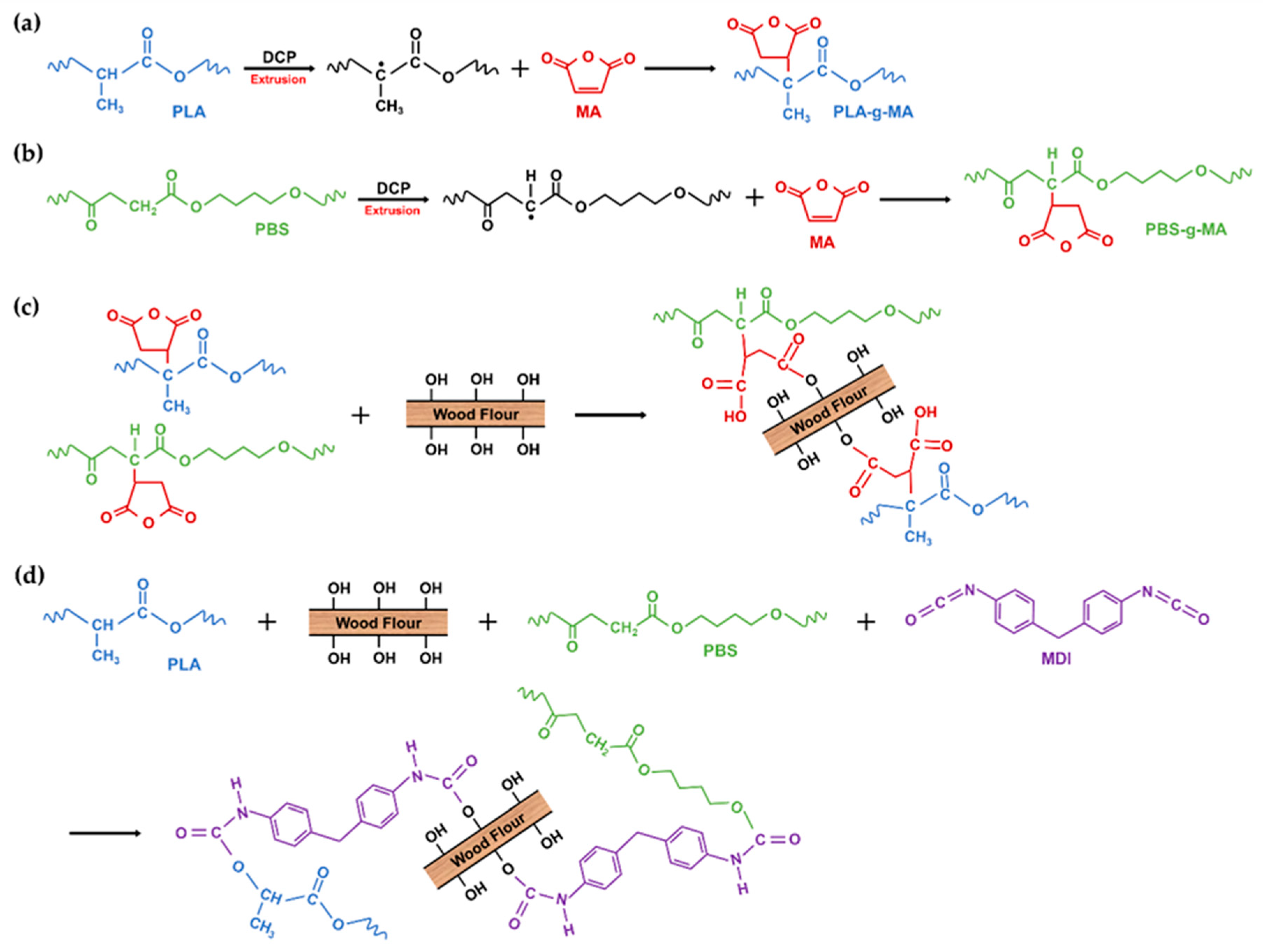
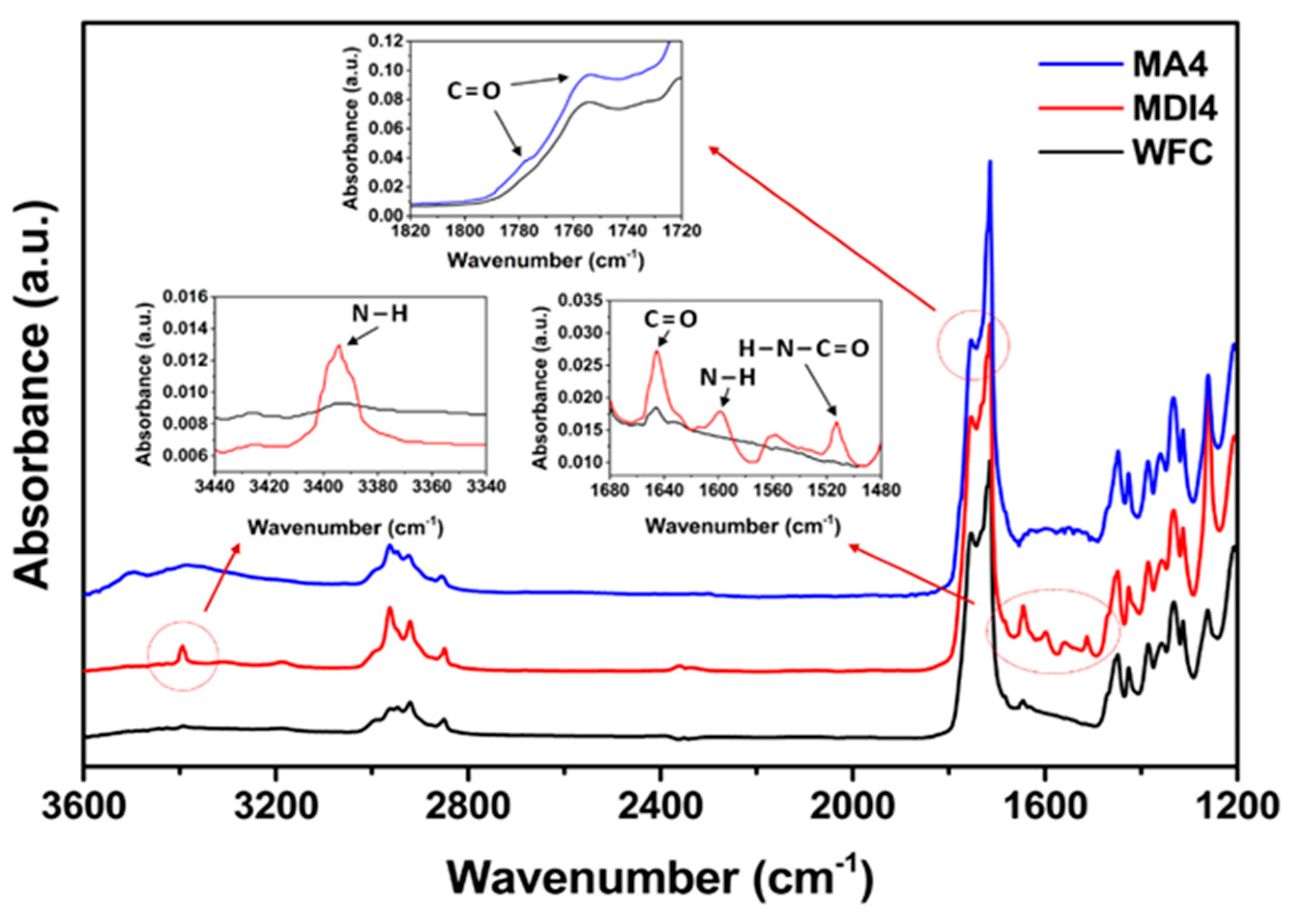
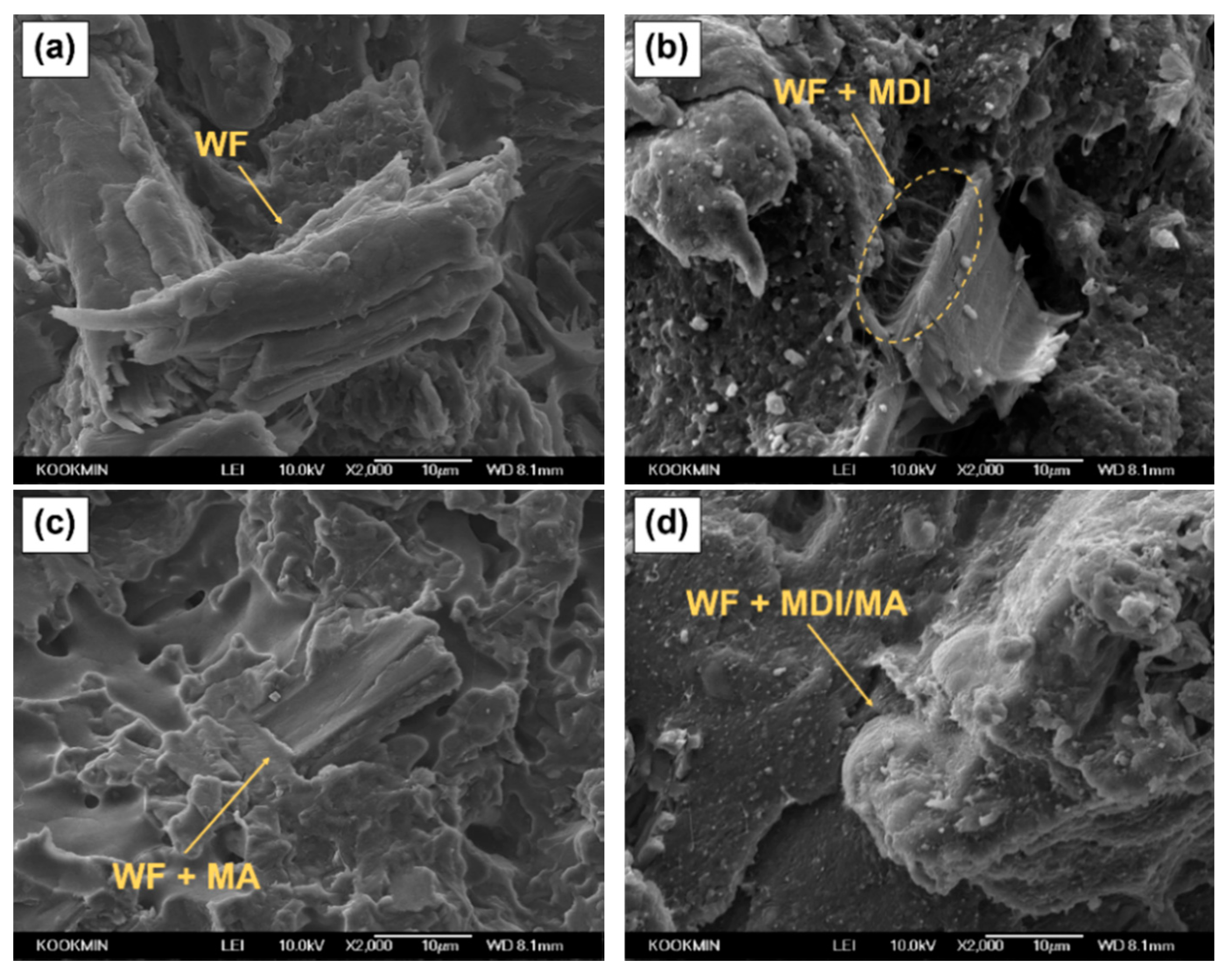
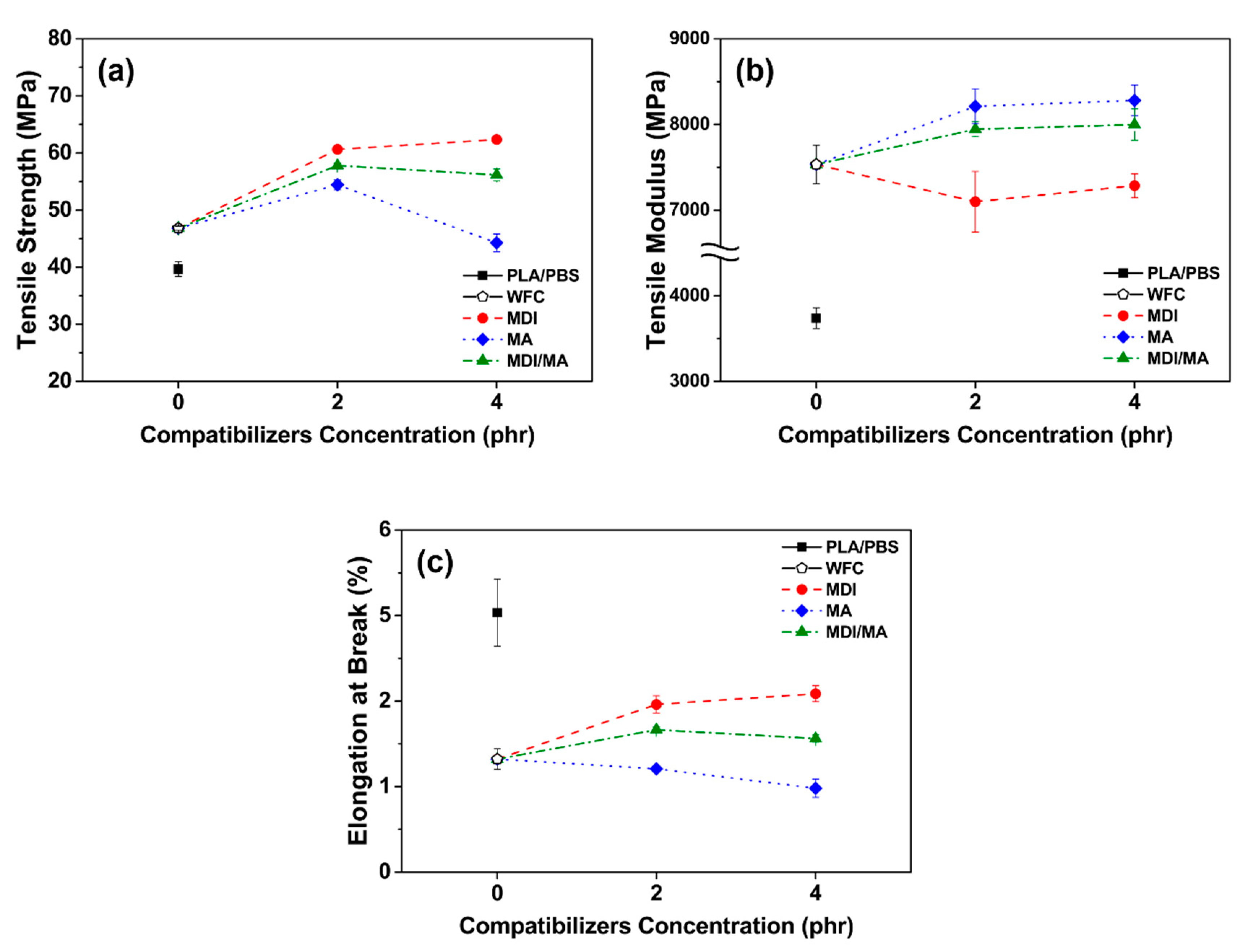
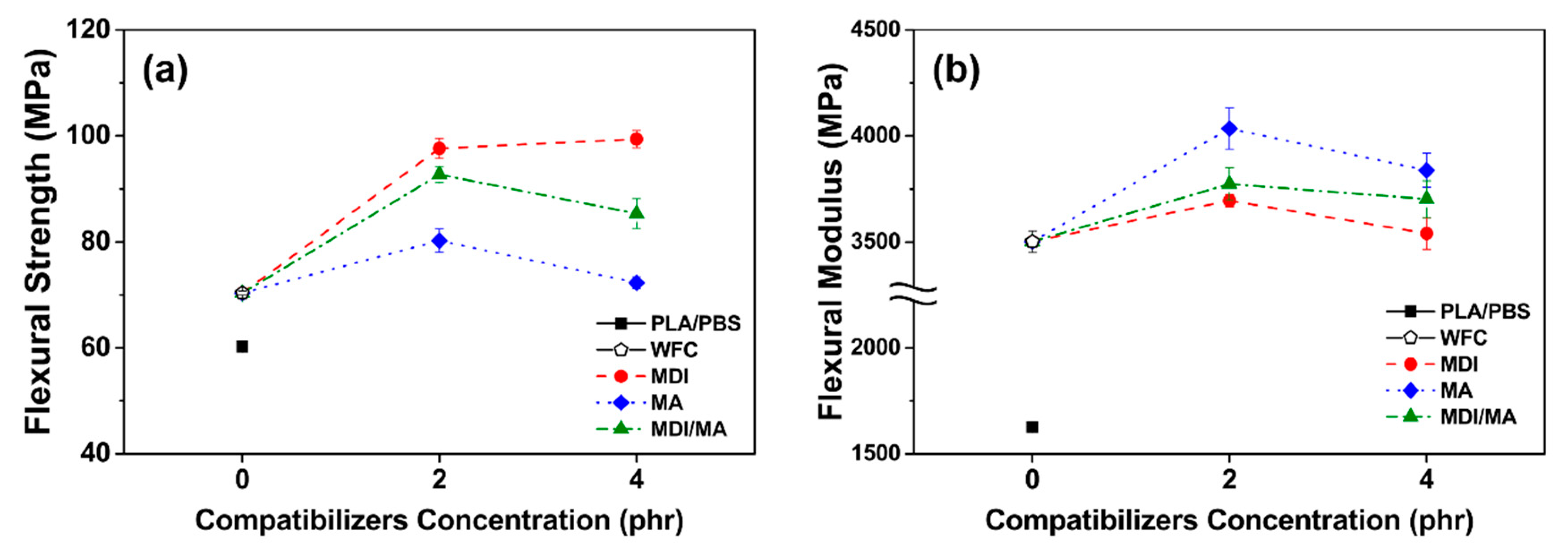


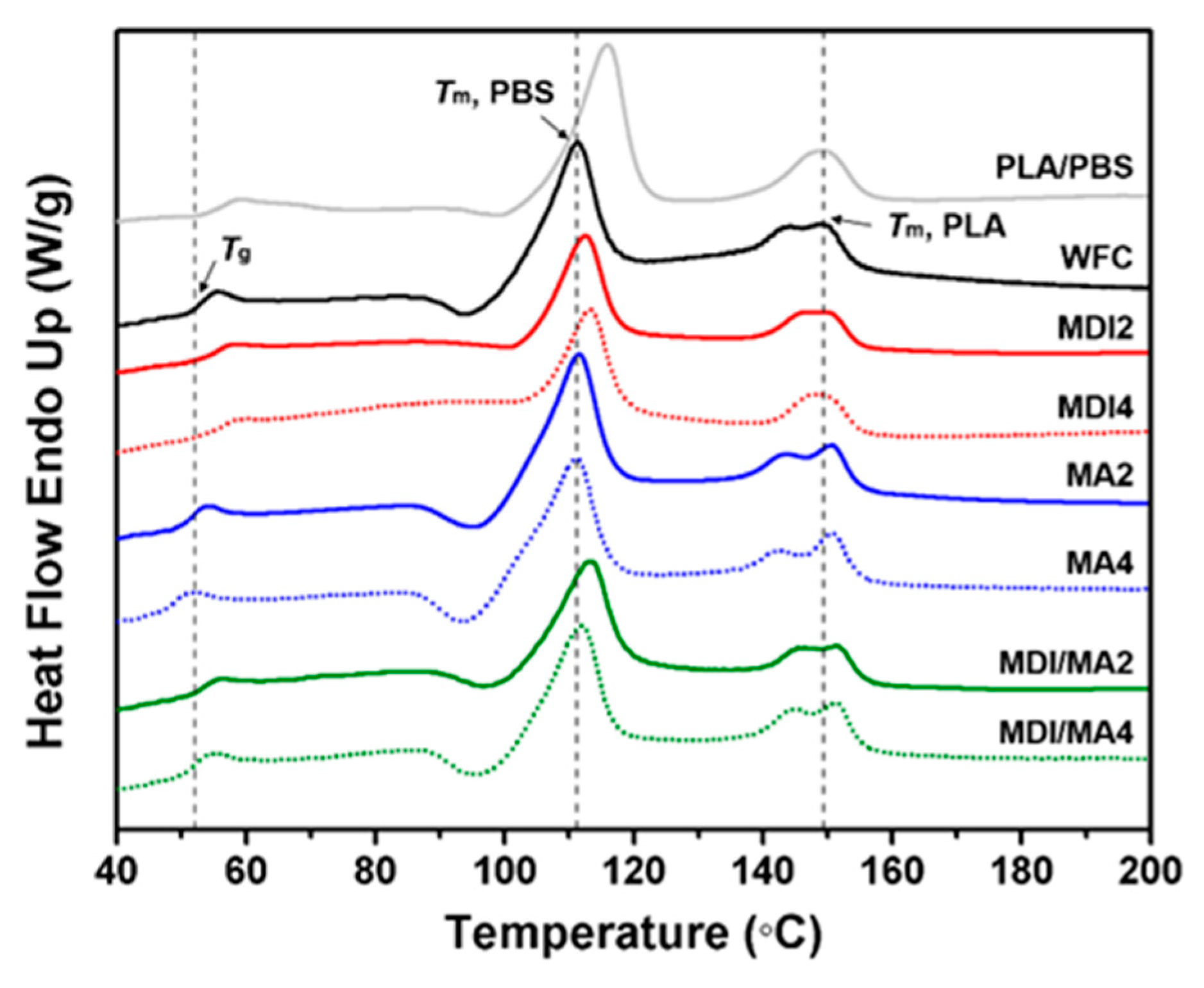
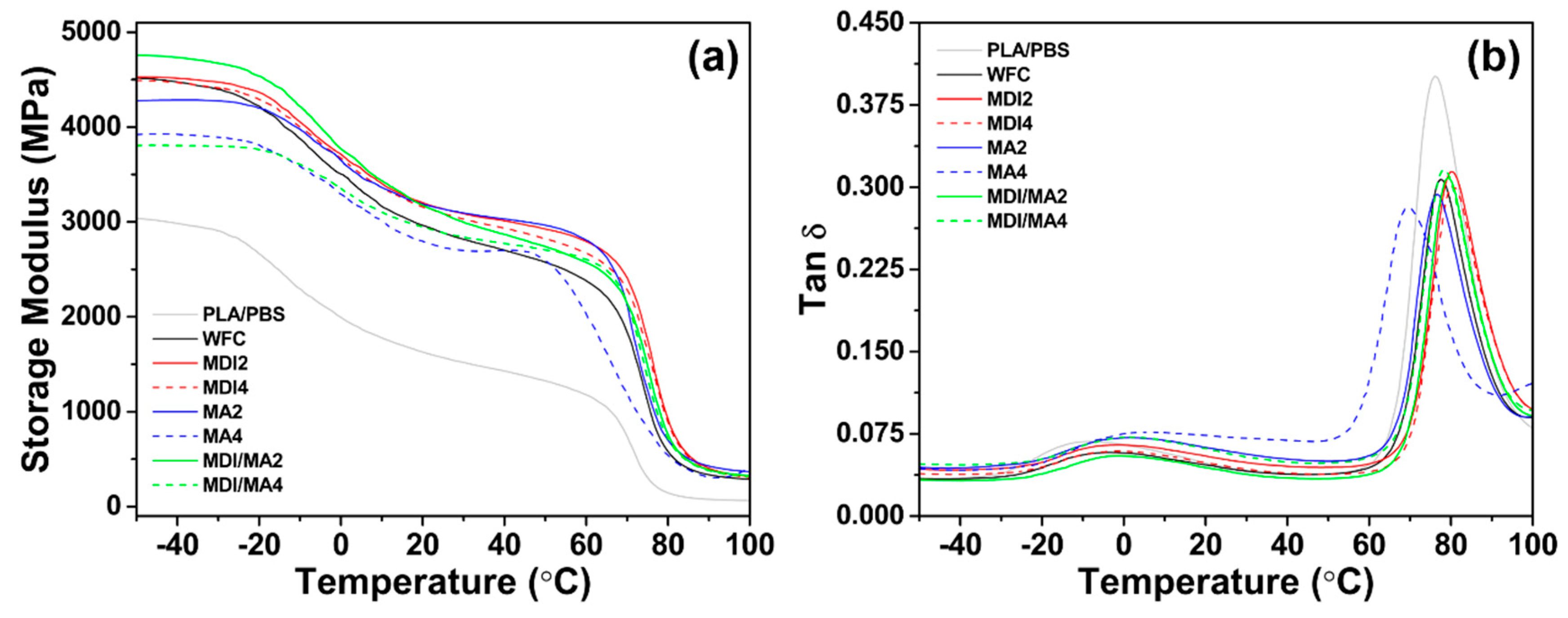
| Specimen | PLA | PBS | WF | MDI | MA | DCP |
|---|---|---|---|---|---|---|
| (wt.%) | (phr 1) | |||||
| PLA/PBS | 50 | 50 | − | − | − | − |
| WFC | 35 | 35 | 30 | − | − | − |
| MDI2 | 35 | 35 | 30 | 2 | − | − |
| MDI4 | 35 | 35 | 30 | 4 | − | − |
| MA2 | 35 | 35 | 30 | − | 2 | 0.2 |
| MA4 | 35 | 35 | 30 | − | 4 | 0.4 |
| MDI/MA2 | 35 | 35 | 30 | 1 | 1 | 0.1 |
| MDI/MA4 | 35 | 35 | 30 | 2 | 2 | 0.2 |
| Specimen | TGA Data | |||
|---|---|---|---|---|
| T95 (°C) | T50 (°C) | TMax1 (°C) | TMax2 (°C) | |
| PLA/PBS | 320.0 | 364.8 | 354.1 | 382.5 |
| WFC | 292.3 | 356.9 | 339.3 | 385.5 |
| MDI2 | 296.6 | 361.7 | 341.0 | 388.8 |
| MDI4 | 294.6 | 361.8 | 334.0 | 386.3 |
| MA2 | 275.6 | 359.3 | 340.4 | 386.8 |
| MA4 | 252.6 | 358.4 | 343.7 | 387.1 |
| MDI/MA2 | 293.3 | 365.3 | 347.5 | 391.5 |
| MDI/MA4 | 288.4 | 361.7 | 338.1 | 388.3 |
| Specimen | PLA component | PBS component | |||||
|---|---|---|---|---|---|---|---|
| Tg (°C) | Tm (°C) | ΔHm (°C) | Xc (%) | Tm (°C) | ΔHm (°C) | Xc (%) | |
| PLA/PBS | 53.6 | 149.2 | 11.9 | 12.8 | 115.9 | 33.1 | 30.0 |
| WFC | 51.1 | 149.3 | 10.4 | 11.2 | 111.2 | 28.5 | 25.9 |
| MDI2 | 52.6 | 150.0 | 7.8 | 8.4 | 112.5 | 19.9 | 18.1 |
| MDI4 | 53.1 | 149.0 | 6.4 | 6.9 | 113.4 | 16.8 | 15.2 |
| MA2 | 49.7 | 150.7 | 11.4 | 12.2 | 111.4 | 30.9 | 28.1 |
| MA4 | 47.7 | 150.8 | 11.6 | 12.5 | 111.0 | 33.5 | 30.3 |
| MDI/MA2 | 51.7 | 151.8 | 8.2 | 8.8 | 112.8 | 26.7 | 24.2 |
| MDI/MA4 | 50.2 | 151.3 | 10.9 | 11.7 | 111.8 | 26.4 | 23.9 |
© 2020 by the authors. Licensee MDPI, Basel, Switzerland. This article is an open access article distributed under the terms and conditions of the Creative Commons Attribution (CC BY) license (http://creativecommons.org/licenses/by/4.0/).
Share and Cite
Seo, Y.-R.; Bae, S.-U.; Gwon, J.; Wu, Q.; Kim, B.-J. Effects of Methylenediphenyl 4,4’-Diisocyanate and Maleic Anhydride as Coupling Agents on the Properties of Polylactic Acid/Polybutylene Succinate/Wood Flour Biocomposites by Reactive Extrusion. Materials 2020, 13, 1660. https://doi.org/10.3390/ma13071660
Seo Y-R, Bae S-U, Gwon J, Wu Q, Kim B-J. Effects of Methylenediphenyl 4,4’-Diisocyanate and Maleic Anhydride as Coupling Agents on the Properties of Polylactic Acid/Polybutylene Succinate/Wood Flour Biocomposites by Reactive Extrusion. Materials. 2020; 13(7):1660. https://doi.org/10.3390/ma13071660
Chicago/Turabian StyleSeo, Young-Rok, Sang-U Bae, Jaegyoung Gwon, Qinglin Wu, and Birm-June Kim. 2020. "Effects of Methylenediphenyl 4,4’-Diisocyanate and Maleic Anhydride as Coupling Agents on the Properties of Polylactic Acid/Polybutylene Succinate/Wood Flour Biocomposites by Reactive Extrusion" Materials 13, no. 7: 1660. https://doi.org/10.3390/ma13071660
APA StyleSeo, Y.-R., Bae, S.-U., Gwon, J., Wu, Q., & Kim, B.-J. (2020). Effects of Methylenediphenyl 4,4’-Diisocyanate and Maleic Anhydride as Coupling Agents on the Properties of Polylactic Acid/Polybutylene Succinate/Wood Flour Biocomposites by Reactive Extrusion. Materials, 13(7), 1660. https://doi.org/10.3390/ma13071660







